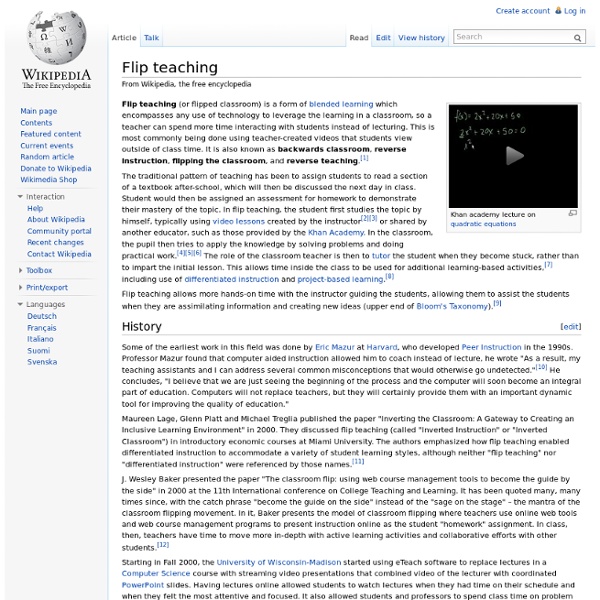Flip teaching

What is the unique idea in Connectivism?
This site has been created to foster discussion on how our thinking, learning, and organizational activities are impacted through technology and societal changes. Since the original publication of Connectivism: A Learning Theory for the Digital Age, I've been approached by many people requesting additional thinking and discussion. Four tools are available to provide dialogue: Blog for my personal reflective thoughtsWiki for collaborative content creationDiscussion forums for discussion on issues impacted by a connectivist view of learningEmail list for discussions on technology, networks and learning Most resources on this site are intended for public viewing, but contributing to the wiki or discussion forums requires registration. If you are interested in general learning and technology trends, please visit my elearnspace site.
en français: MOODLE et e-learning maker
Bonjour, J'ai également une licence ELM ... je suis plutôt d'accord avec ce qui a été dit par Thierry et Daniel (pratique pour des petites choses, pas trop compliqué à prendre en main même si une formation minimale s'impose, un rendu ludique, des activités diversifiées et une vraie logique de conception derrière tout ca mais un peu lourd en export, payant, pas toujours ergonomique, ...). Je pense que le mieux pour vous est de le tester car nous ne connaissons pas assez votre contexte et les contenus que vous souhaitez développer avec ! Comme Daniel, j'utilise plutôt Scenari et le modèle OpaleSup mais il faut admettre que c'est beaucoup plus basé sur une logique "documentaire" alors qu'ELM a une philosophie orientée "activités". Dans le détail des tentatives sur Moodle, on obtient (voir la copie d'écran ci jointe) dans le dernier paramètre cmi.suspend_data quelques données que j'interpréterais comme suit : A = numéro de l'écran d'activité D = score de l'activité Bonne journée
Taxonomie de Bloom
Un article de Wiki Paris Descartes. Des clés pour comprendre l'Université numérique Qu'est-ce qu'un objectif pédagogique ? Dans le processus enseignement- apprentissage , et pour une bonne évaluation , il est important que soient définis précisément les objectifs pédagogiques poursuivis et de les formuler clairement aux apprenants . En pédagogie, un objectif est un énoncé d’intention décrivant ce que l’apprenant saura (ou saura faire) après apprentissage. Un objectif pédagogique général décrit une compétence ou un ensemble de compétences que l’apprenant doit acquérir au terme d’une séquence d’apprentissage. Les objectifs pédagogiques généraux ne peuvent donner prise à une évaluation rigoureuse que s’ils sont rendus concrets. Formuler un objectif pédagogique opérationnel/spécifique, c'est définir pour l'élève : Taxonomie des objectifs pédagogiques de Bloom Elle permet, en outre, d'identifier la nature des capacités sollicitées par un objectif de formation et son degré de complexité.
Related:
Related:



